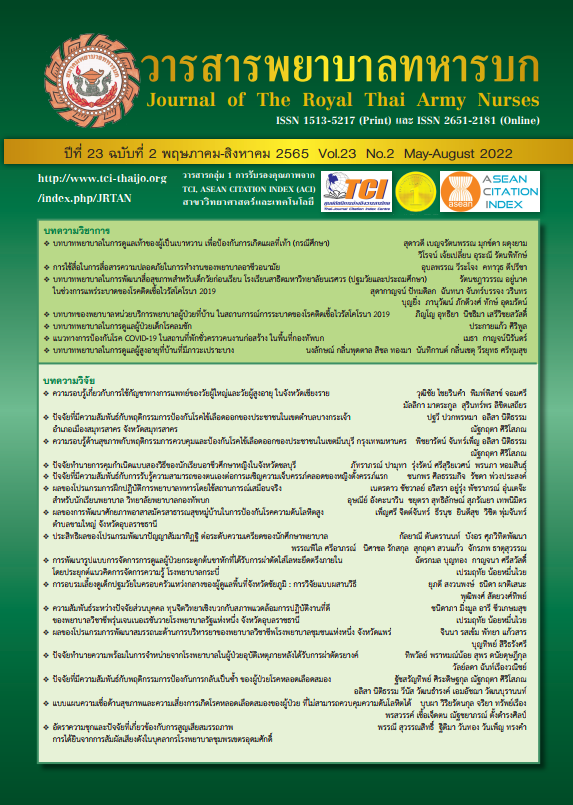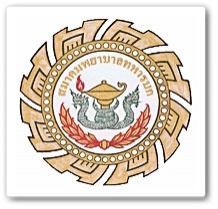Factors Related to Perceived Self-Efficacy in Coping with Labor Pain in Primiparous Pregnant Women
Keywords:
Perceived Self-Efficacy in Coping with Labor Pain, Primiparous Pregnant WomenAbstract
The objective of this descript study was to examine factors related to Perceived Self-Efficacy in Coping with Labor Pain Among Primiparous Women. Research participants were 128 first-time pregnant women attending ante natal care clinic at Samutprakarn hospital. They were recruited in the study by simple random sampling. Data were collected by using questionnaires of including Personal record form, Childbirth self-efficacy inventory Questionnaire, Attitude towards Childbirth Questionnaire, Labor Social support Questionnaire and Thai Version of Childbirth Self-efficacy Inventory. Data were analyzed by using descriptive statistics and Pearson product moment correlation coefficients.
The results showed that there was statistically significant positive correlation between education (r = .069, p = .438), status (r = .029, p = .745), length time of labor (r = .074, p = .405), Attitude towards Childbirth (r = .046, p = .604), and Social support at the alpha level .05.
Downloads
References
Brubaker, S. J., & Dillaway, H. E. Medicalization, natural childbirth and birthing experiences. Sociology Compass. 2009;3,31-48.
Lowdermilk, D.L. Labor and birth processes. In D. L. Lowdermilk, S.E. Perry, K. Cashion, & K.R. Alden (Eds.), Maternity & women’ s health care. 2012; 10thed.,:369-385 St Louis, MO: Elsevier Mosby.
Boonpongmanee C, Chunuan S, Somsap Y.Effects of empowerment and continuous support on psychological factors, pain coping behaviors, and birth outcomes. Thesis of Master Nursing (Midwifery), Faculty of Nursing, Prince of Songkla. 2017. (in Thai).
winitchai N. An effect of labor support program on anxiety in primiprous parturients with oxytocin augmentation. Thesis of Master Nursing (Midwifery), Faculty of Nursing, Mahidol University, 2017. (in Thai).
lumpikanon P. Caesarean section is not the last answer. [journal]. Obstetrics Association. 2018; 27(1): 18-25. (in Thai).
Kashanian M. and Javadi F. Effect of continuous support during labor on duration of labor and rate of cesarean delivery. International Journal of Gynecology and Obstetrics. 2017; 109(3): 198-200.
Bandura, A. Self-efficacy: The exercise of control. New York: Freeman. Barrows, J., Dunn, S., & Lloyd, A. C. Anxiety, self-efficacy, and college exam grades. Universal Journal of Educational Research. 1997; 1(3): 204-208.
World Health Organization [WHO]. World Health Organization partograph in management of labour. Lancet. 1997; 343(8910): 1399-404
Lowe, N. K. Critical predictors of sensory and affective pain during four phases of labor. Journal of Psychosomatic Obstetrics and Gynaecology. 1993; 12: 192-198.
Tanglakmankhong, K., Perrin, N. A., & Lowe, N. K. Childbirth self-efficacy inventory and ch ildb irth att itudes quest ionna ire : Psychometric properties of Thai language versions. Journal of Advanced Nursing. 2018; 67(1): 193-203.
Kundu, A., & Ghose, A. The relationship between attitude and self-efficacy in mathematics among higher secondary students. Journal of Humanities and Social Science. 2017; 21(4): 25-31.
Schwartz, L., Toohill, J., Creedy, D. K., Baird, K., Gamble, J., & Fenwick, J. Factors associated with childbirth self-efficacy in Australian childbearing women. BioMed Central Pregnancy & Childbirth. 2017; 15(1): 2-9.
Klomyong S. Factors influencing qualified antenatal care among pregnant. adolescents. Thesis of Master Nursing (Midwifery), Faculty of Nursing, Burapha University, 2019. (in Thai).
Tachasuksri T, Siriarunrat S, Suppasri P, Suppaseemanont W, Boonnate N and Kwannate C. Causal Model for Quality of Life among Pregnant Women. The Southern College Network Journal of Nursing and Public Health. 2017;4(1): 28-46. (in Thai).
Pancharern S. Factors related to the Intention to Repeat Pregnancy Among Pregnant Adolescents. Journal of Social Science and Buddhistic Anthropology. 2020; 4(1): 126-120. (in Thai).
Phoeiklang P. Factors Predicting Fear of Childbirth Among Postpartum Women. Nursing Journal. 2017; 43(4): 256-266. (in Thai).
Davidson, M. R., London, M. L., & Ladewig, P. A. W. Olds’ maternal-newborn nursing & women’s health across the lifespan. 8th ed. Upper Saddle River, NJ: Pearson Education; 2008.
Lavender, T., Walkinshaw, H., & Walton, l. A prospective study of women’s views of factors contributing to a positive birth experience. Midwifery. 1999; 28: 40-46.
Goodman, P., Mackey, M. C., & Tavakoli, A. S.Factors related to childbirth satisfaction. Journal of Advanced Nursing. 2004; 46(2): 212-219.
Downloads
Published
How to Cite
Issue
Section
License
Copyright (c) 2022 Journal of The Royal Thai Army Nurses

This work is licensed under a Creative Commons Attribution-NonCommercial-NoDerivatives 4.0 International License.
บทความหรือข้อคิดเห็นใดใดที่ปรากฏในวารสารพยาบาลทหารบกเป็นวรรณกรรมของผู้เขียน ซึ่งบรรณาธิการหรือสมาคมพยาบาลทหารบก ไม่จำเป็นต้องเห็นด้วย
บทความที่ได้รับการตีพิมพ์เป็นลิขสิทธิ์ของวารสารพยาบาลทหารบก
The ideas and opinions expressed in the Journal of The Royal Thai Army Nurses are those of the authors and not necessarily those
of the editor or Royal Thai Army Nurses Association.






